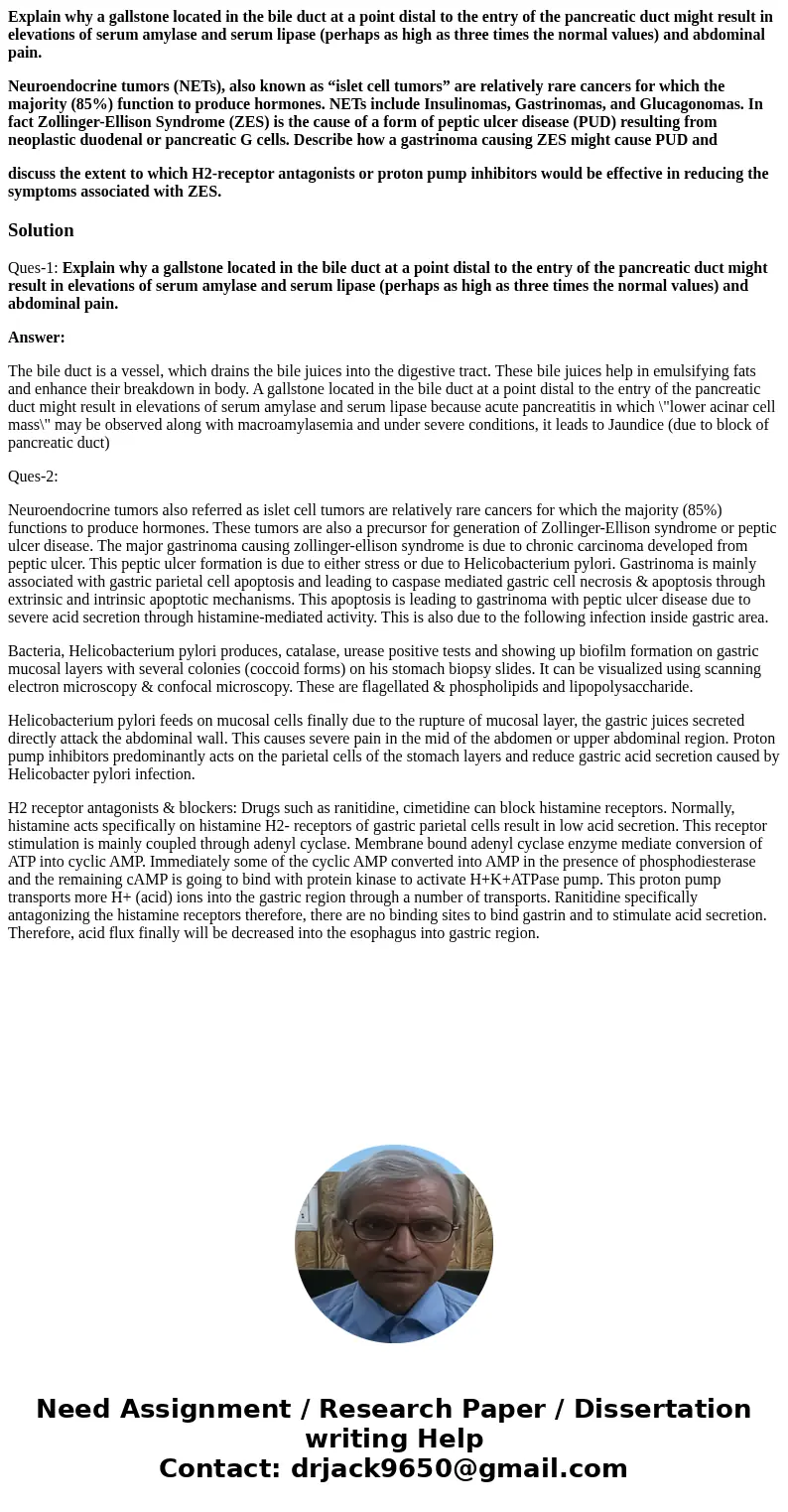Explain why a gallstone located in the bile duct at a point
Explain why a gallstone located in the bile duct at a point distal to the entry of the pancreatic duct might result in elevations of serum amylase and serum lipase (perhaps as high as three times the normal values) and abdominal pain.
Neuroendocrine tumors (NETs), also known as “islet cell tumors” are relatively rare cancers for which the majority (85%) function to produce hormones. NETs include Insulinomas, Gastrinomas, and Glucagonomas. In fact Zollinger-Ellison Syndrome (ZES) is the cause of a form of peptic ulcer disease (PUD) resulting from neoplastic duodenal or pancreatic G cells. Describe how a gastrinoma causing ZES might cause PUD and
discuss the extent to which H2-receptor antagonists or proton pump inhibitors would be effective in reducing the symptoms associated with ZES.
Solution
Ques-1: Explain why a gallstone located in the bile duct at a point distal to the entry of the pancreatic duct might result in elevations of serum amylase and serum lipase (perhaps as high as three times the normal values) and abdominal pain.
Answer:
The bile duct is a vessel, which drains the bile juices into the digestive tract. These bile juices help in emulsifying fats and enhance their breakdown in body. A gallstone located in the bile duct at a point distal to the entry of the pancreatic duct might result in elevations of serum amylase and serum lipase because acute pancreatitis in which \"lower acinar cell mass\" may be observed along with macroamylasemia and under severe conditions, it leads to Jaundice (due to block of pancreatic duct)
Ques-2:
Neuroendocrine tumors also referred as islet cell tumors are relatively rare cancers for which the majority (85%) functions to produce hormones. These tumors are also a precursor for generation of Zollinger-Ellison syndrome or peptic ulcer disease. The major gastrinoma causing zollinger-ellison syndrome is due to chronic carcinoma developed from peptic ulcer. This peptic ulcer formation is due to either stress or due to Helicobacterium pylori. Gastrinoma is mainly associated with gastric parietal cell apoptosis and leading to caspase mediated gastric cell necrosis & apoptosis through extrinsic and intrinsic apoptotic mechanisms. This apoptosis is leading to gastrinoma with peptic ulcer disease due to severe acid secretion through histamine-mediated activity. This is also due to the following infection inside gastric area.
Bacteria, Helicobacterium pylori produces, catalase, urease positive tests and showing up biofilm formation on gastric mucosal layers with several colonies (coccoid forms) on his stomach biopsy slides. It can be visualized using scanning electron microscopy & confocal microscopy. These are flagellated & phospholipids and lipopolysaccharide.
Helicobacterium pylori feeds on mucosal cells finally due to the rupture of mucosal layer, the gastric juices secreted directly attack the abdominal wall. This causes severe pain in the mid of the abdomen or upper abdominal region. Proton pump inhibitors predominantly acts on the parietal cells of the stomach layers and reduce gastric acid secretion caused by Helicobacter pylori infection.
H2 receptor antagonists & blockers: Drugs such as ranitidine, cimetidine can block histamine receptors. Normally, histamine acts specifically on histamine H2- receptors of gastric parietal cells result in low acid secretion. This receptor stimulation is mainly coupled through adenyl cyclase. Membrane bound adenyl cyclase enzyme mediate conversion of ATP into cyclic AMP. Immediately some of the cyclic AMP converted into AMP in the presence of phosphodiesterase and the remaining cAMP is going to bind with protein kinase to activate H+K+ATPase pump. This proton pump transports more H+ (acid) ions into the gastric region through a number of transports. Ranitidine specifically antagonizing the histamine receptors therefore, there are no binding sites to bind gastrin and to stimulate acid secretion. Therefore, acid flux finally will be decreased into the esophagus into gastric region.

 Homework Sourse
Homework Sourse